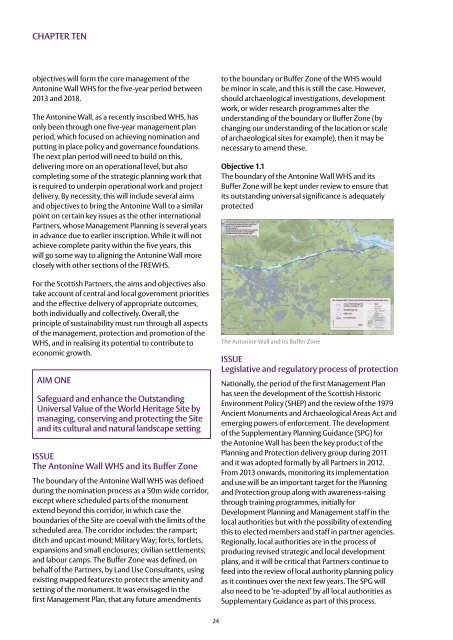The Antonine Wall Management Plan 2013-18 - Glasgow City Council
The Antonine Wall Management Plan 2013-18 - Glasgow City Council
The Antonine Wall Management Plan 2013-18 - Glasgow City Council
You also want an ePaper? Increase the reach of your titles
YUMPU automatically turns print PDFs into web optimized ePapers that Google loves.
chapter ten<br />
objectives will form the core management of the<br />
<strong>Antonine</strong> <strong>Wall</strong> WHS for the five-year period between<br />
<strong>2013</strong> and 20<strong>18</strong>.<br />
<strong>The</strong> <strong>Antonine</strong> <strong>Wall</strong>, as a recently inscribed WHS, has<br />
only been through one five-year management plan<br />
period, which focused on achieving nomination and<br />
putting in place policy and governance foundations.<br />
<strong>The</strong> next plan period will need to build on this,<br />
delivering more on an operational level, but also<br />
completing some of the strategic planning work that<br />
is required to underpin operational work and project<br />
delivery. By necessity, this will include several aims<br />
and objectives to bring the <strong>Antonine</strong> <strong>Wall</strong> to a similar<br />
point on certain key issues as the other international<br />
Partners, whose <strong>Management</strong> <strong>Plan</strong>ning is several years<br />
in advance due to earlier inscription. While it will not<br />
achieve complete parity within the five years, this<br />
will go some way to aligning the <strong>Antonine</strong> <strong>Wall</strong> more<br />
closely with other sections of the FREWHS.<br />
For the Scottish Partners, the aims and objectives also<br />
take account of central and local government priorities<br />
and the effective delivery of appropriate outcomes,<br />
both individually and collectively. Overall, the<br />
principle of sustainability must run through all aspects<br />
of the management, protection and promotion of the<br />
WHS, and in realising its potential to contribute to<br />
economic growth.<br />
aim one<br />
Safeguard and enhance the Outstanding<br />
Universal Value of the World Heritage Site by<br />
managing, conserving and protecting the Site<br />
and its cultural and natural landscape setting<br />
Issue<br />
<strong>The</strong> <strong>Antonine</strong> <strong>Wall</strong> WHS and its Buffer Zone<br />
<strong>The</strong> boundary of the <strong>Antonine</strong> <strong>Wall</strong> WHS was defined<br />
during the nomination process as a 50m wide corridor,<br />
except where scheduled parts of the monument<br />
extend beyond this corridor, in which case the<br />
boundaries of the Site are coeval with the limits of the<br />
scheduled area. <strong>The</strong> corridor includes: the rampart;<br />
ditch and upcast mound; Military Way; forts, fortlets,<br />
expansions and small enclosures; civilian settlements;<br />
and labour camps. <strong>The</strong> Buffer Zone was defined, on<br />
behalf of the Partners, by Land Use Consultants, using<br />
existing mapped features to protect the amenity and<br />
setting of the monument. It was envisaged in the<br />
first <strong>Management</strong> <strong>Plan</strong>, that any future amendments<br />
to the boundary or Buffer Zone of the WHS would<br />
be minor in scale, and this is still the case. However,<br />
should archaeological investigations, development<br />
work, or wider research programmes alter the<br />
understanding of the boundary or Buffer Zone (by<br />
changing our understanding of the location or scale<br />
of archaeological sites for example), then it may be<br />
necessary to amend these.<br />
Objective 1.1<br />
<strong>The</strong> boundary of the <strong>Antonine</strong> <strong>Wall</strong> WHS and its<br />
Buffer Zone will be kept under review to ensure that<br />
its outstanding universal significance is adequately<br />
protected<br />
<strong>The</strong> <strong>Antonine</strong> <strong>Wall</strong> and its Buffer Zone<br />
Issue<br />
Legislative and regulatory process of protection<br />
Nationally, the period of the first <strong>Management</strong> <strong>Plan</strong><br />
has seen the development of the Scottish Historic<br />
Environment Policy (SHEP) and the review of the 1979<br />
Ancient Monuments and Archaeological Areas Act and<br />
emerging powers of enforcement. <strong>The</strong> development<br />
of the Supplementary <strong>Plan</strong>ning Guidance (SPG) for<br />
the <strong>Antonine</strong> <strong>Wall</strong> has been the key product of the<br />
<strong>Plan</strong>ning and Protection delivery group during 2011<br />
and it was adopted formally by all Partners in 2012.<br />
From <strong>2013</strong> onwards, monitoring its implementation<br />
and use will be an important target for the <strong>Plan</strong>ning<br />
and Protection group along with awareness-raising<br />
through training programmes, initially for<br />
Development <strong>Plan</strong>ning and <strong>Management</strong> staff in the<br />
local authorities but with the possibility of extending<br />
this to elected members and staff in partner agencies.<br />
Regionally, local authorities are in the process of<br />
producing revised strategic and local development<br />
plans, and it will be critical that Partners continue to<br />
feed into the review of local authority planning policy<br />
as it continues over the next few years. <strong>The</strong> SPG will<br />
also need to be ‘re-adopted’ by all local authorities as<br />
Supplementary Guidance as part of this process.<br />
24












![Elgin Cathedral Wedding Brochure [pdf, 544kb] - Historic Scotland](https://img.yumpu.com/22301571/1/190x151/elgin-cathedral-wedding-brochure-pdf-544kb-historic-scotland.jpg?quality=85)



